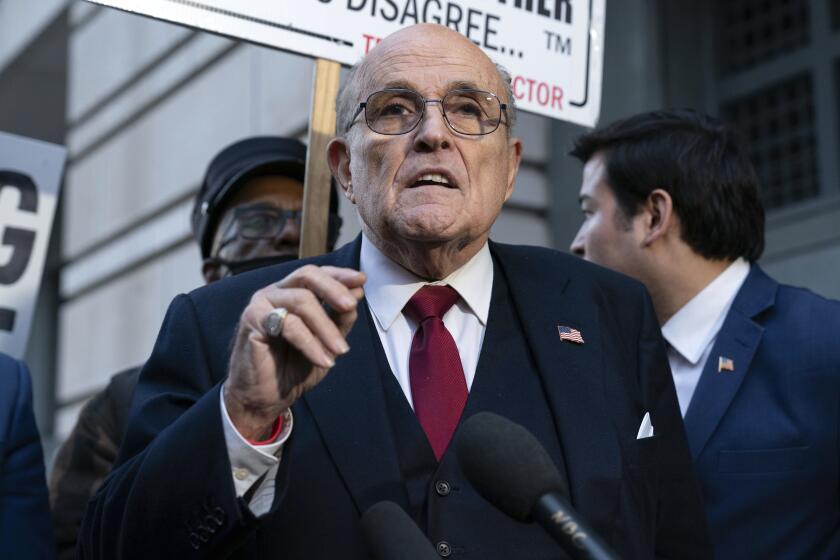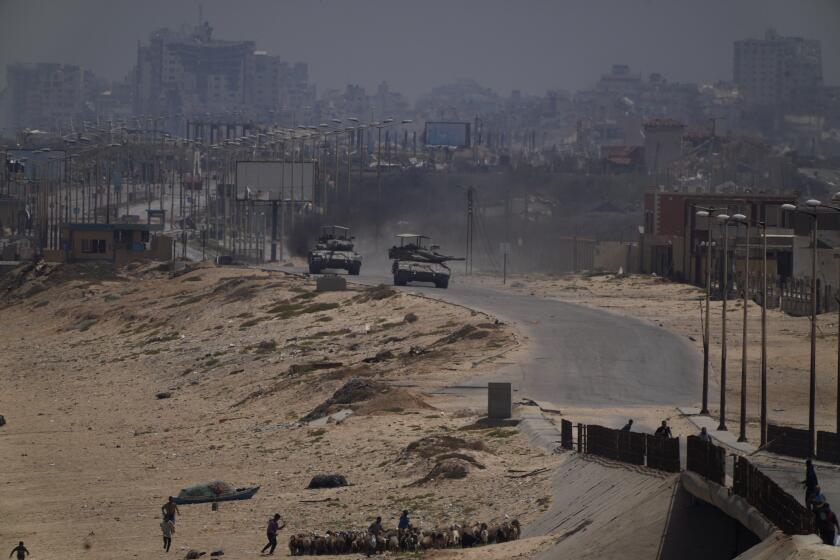BP cap to remain as storm moves in
Reassured by a week of intense monitoring, federal officials Thursday said they planned to leave the damaged BP well sealed despite evacuating vessels ahead of Tropical Storm Bonnie, which was bearing down on the Gulf of Mexico.
The storm, raking the Bahamas late Thursday, is projected to sweep through the gulf with winds of 40 mph or greater and reach the vicinity of the BP well site early Saturday.
Coast Guard officials have started moving cleanup equipment inland from low-lying coastal areas, re-anchoring booms and readying vessels for evacuation from the spill site, 50 miles off Louisiana’s shore.
The drilling of two relief wells is being suspended, setting back by several days the procedure that will enable BP to plug the blown-out well permanently.
Retired Adm. Thad Allen, the national incident commander, said the last boats to leave the scene in the event of heavy seas would be those operating the deep-sea robots that have continuously scanned the wellhead and sea bottom for signs of new leaks since the recently placed cap was closed last week, tamping down oil that had gushed for nearly three months.
But even if the underwater sentries head for shore, Allen said, Energy Secretary Steven Chu and his science team have gained enough knowledge of the seabed around the site to leave the well shut without fear of oil erupting through the seafloor from cracks in the well and adjacent rock.
“We’re starting to create almost a 3-D model of what the formation around that well looks like, and that allows us to rule out potential sources or indications there might be a leak,” Allen said.
With the deep-sea leak sealed for a week, areas of heavy oil are shrinking and waters around the well are turning a welcome shade of blue.
The National Oceanic and Atmospheric Administration announced it was reopening to commercial and recreational fishing more than 26,000 square miles of the gulf, or a third of the overall area that has been closed.
Still, Allen said, “hundreds of thousands of patches of oil” are drifting around the gulf and could be further dispersed by the storm, which could drive the slick fragments into fragile marsh areas.
As crews prepared for high winds and waves, an investigative hearing on the cause of the BP disaster continued outside New Orleans.
Federal investigators pressed their case that the oil giant cut corners and made decisions that compromised safety in order to save time and money on a project that was over budget and behind schedule.
They referred to a decision not to use a well liner that would have been another barrier to prevent natural gas from erupting out of the well and up to the Deepwater Horizon rig. Although internal BP e-mails cited the time it would take to install the liner, as well as the $7 million to $10 million it would cost, BP team leader John Guide testified Thursday that cost-cutting was not a factor.
Investigators on the Coast Guard-Interior Department panel focused on what they identified as 15 “risk-based decisions,” quizzing Guide in each instance on the drilling methods BP chose.
The day’s first witness, the widow of one of the 11 men killed in the Deepwater Horizon explosion and fire on April 20, said that “from Day One,” her husband “deemed this hole a ‘well from hell.’ ”
“He said, ‘Mother Nature just doesn’t want to be drilled here,’ ” testified Natalie Roshto, widow of Shane Roshto.
It was a sentiment shared by at least one other BP employee. At the end of the day, an e-mail from BP drilling engineer Mark Hafle was read in which the engineer referred to the well as “a crazy well.”
Investigators suggested that if certain diagnostic tests had been conducted, rig managers would have obtained a clearer picture of conditions in the troublesome well, which had been sending up powerful “kicks” of natural gas, indicating drillers were having trouble controlling the well, 18,000 feet beneath the gulf surface.
Among the procedures the company chose not to conduct was an $118,000 integrity test of the well’s cement plug. BP also did not perform a circulation test that would have better prepared the well for cementing, which affixes well casing to adjoining rock and fills gaps through which oil and gas could flow uncontrolled.
BP’s design for the failed well has been in question because it relied on a single pipe, called a production casing, pushed down the well and plastered in place by cement.
The unconventional design would need additional testing, and it could provide an open avenue for gas to travel up to the wellhead, BP’s engineers wrote in a report.
There were disagreements among BP officials and contractors about properly centering the casing, a crucial procedure that ensures more uniform cementing of the casing to adjacent rock. Improper centering can leave voids that could allow oil and gas to flow unexpectedly up the well.
The contractor Halliburton warned BP two days before the explosion that the company’s plan to use fewer centralizers in the well hole would create a “severe gas flow problem” and recommended that BP install an additional 15 of the devices.
Guide wrote an e-mail complaining that it would take 10 hours to install them and expressing annoyance that an underling had ordered them without his knowledge. The extra centralizers arrived on the rig April 16 but were not used because they were the wrong type.
Guide could not explain why the devices were not reordered.
Guide said he believed that six centralizers would be sufficient, but under questioning by a Halliburton lawyer, Guide admitted he could not think of another instance in which BP failed to adopt Halliburton’s recommendations regarding a cement job.
BP was also criticized from within the oil industry Thursday.
In an interview with Fox Business Network, ConocoPhilips Chief Executive James Mulva said he thought the disaster “was preventable and the response capability was inadequate.”
ConocoPhilips is one of four oil companies that announced this week that they are launching a $1-billion effort to develop a rapid-response system to better deal with deep-water well blowouts.
--
ron.lin@latimes.com
bettina.boxall@latimes.com
Times staff writer Jill Leovy in Los Angeles contributed to this report.
More to Read
Start your day right
Sign up for Essential California for news, features and recommendations from the L.A. Times and beyond in your inbox six days a week.
You may occasionally receive promotional content from the Los Angeles Times.









